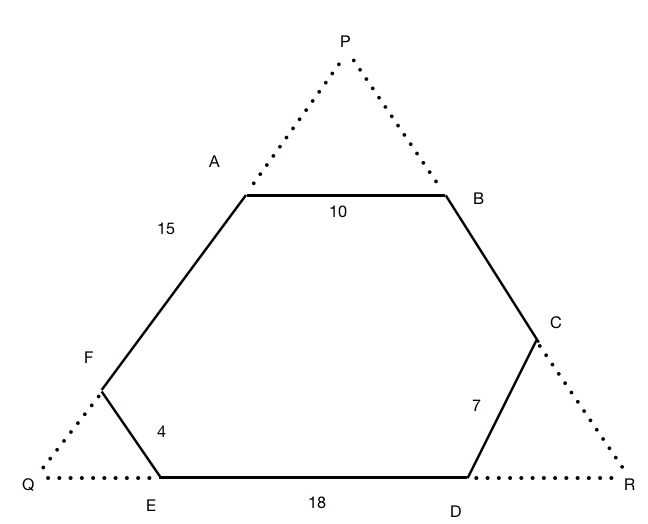
Today, we will look at a relatively difficult polygon question. We would like to remind you here that the concepts tested are still very simple – though we wouldn’t like to give away just exactly which concepts they are. Take a look at the question first.

Question: The hexagon above has interior angles whose measures are all equal. As shown, only five of the six side lengths are known: 10, 15, 4, 18, and 7. What is the unknown side length?
(A) 7
(B) 10
(C) 12
(D) 15
(E) 16
Solution: There are various ways to solve this question but each takes a bit of effort. Note that it is not a regular polygon since the side lengths are not all equal. But the angles are all equal. Let’s first find the measure of each one of those angles using the formula discussed in our previous post.
![]() = Sum of all interior angles
= Sum of all interior angles
![]()
Each of the 6 angles ![]() degrees
degrees
Though we would like to point out here that if you see a question such as this one in your actual test, you would already know that if each angle of a hexagon is equal, then each angle must be 120 degree. So the calculation given above would not be needed.
Method 1: Visualisation
This is a very valid approach to get the correct answer in GMAT since we don’t need to explain the reasoning or show the steps. But yes, it may be hard to comprehend for the beginners. We will anyway try to explain it since it needs no work and helps build Math instinct.
Note that in this hexagon, each angle is 120 degree and hence each pair of opposite sides are parallel. Think of it this way: Side 4 turns on side 18 by 120 degrees. Then side 15 turns on side 4 by another 120 degrees. And finally, side 10 turns on side 15 by another 120 degrees. So side 10 has, in effect, turned by 360 degrees on side 18.
This means side 10 is parallel to side 18.
Now think of the 120 degree angle between side 4 and side 15. It has to be kept constant. Plus the angle of the legs has to stay constant at 120 degree each with sides 10 and 18. Since the slope of each leg of that angle is negative of each other (![]() and
and ![]() ). When one leg gets shorter, the other gets longer by the same length.
). When one leg gets shorter, the other gets longer by the same length.

Hence, the sum of the sides will always be 15 + 4 = 19
This means 7 + Unknown = 19
Unknown = 12
We understand if you struggled to understand the approach above. It involves a lot of intuition to see this concept on your own. So let’s give you a couple of more tangible solutions!
Method 2: Right triangles

As we have seen in method 1 above, ![]() and
and ![]() are parallel lines. Since each of the angles
are parallel lines. Since each of the angles ![]() and
and ![]() are 120 degrees each, the four triangles we have made are all 30-60-90 triangles. The sides of a 30-60-90 triangle is in the ratio
are 120 degrees each, the four triangles we have made are all 30-60-90 triangles. The sides of a 30-60-90 triangle is in the ratio ![]() .
.
So ![]()
And ![]()
So the distance between the sides of length 10 and 18 is ![]()
We know that ![]()
So ![]()
Then, since ratio of sides should be ![]() , side
, side ![]()
Method 3: Equilateral Triangle

Extend the sides as shown. Since each internal angle is 120 degrees, each external angle will be 60 degrees. In that case each angle between the dotted lines becomes 60 degrees too and hence triangle ![]() becomes an equilateral triangle. This means
becomes an equilateral triangle. This means ![]() . Triangle
. Triangle ![]() becomes an equilateral triangle so
becomes an equilateral triangle so ![]() . Triangle
. Triangle ![]() is also an equilateral triangle and
is also an equilateral triangle and ![]() .
.
Now note that since angles ![]() and
and ![]() are all 60 degrees each, triangle
are all 60 degrees each, triangle ![]() is also equilateral and hence
is also equilateral and hence ![]()
![]()
![]()
![]()
Answer (C).
Note the concepts used here: regular polygon, parallel lines, angles, 30-60-90 right triangles, equilateral triangles
We know all these very well but applying them here takes some ingenuity!